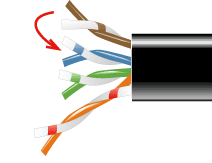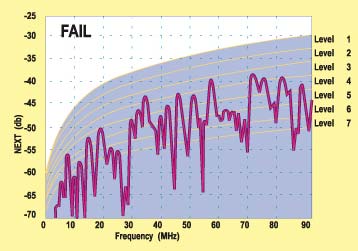Power Sum NEXT (PS-NEXT)
Power Sum NEXT (PS-NEXT) is the sum of the total NEXT power copuled to a wire pair from all other adjacent pairs. NEXT (Near-end crosstalk) is the level of interference that occurs between one pair and another pair within a four-pair cable. TSB-67 requires that pair-to-pair NEXT be measured on all pair combinations in a cable. The worst pair-to-pair NEXT measure should not exceed the cable's specified limits.
PS-NEXT is a much more rigorous crosstalk measurement than NEXT.
It measures the total possible crosstalk coupled from multiple wire pairs in the same cable sheath, not just the crosstalk from any one pair to another pair. According to TIA 568A, PS-NEXT is the required method for measuring NEXT of backbone cable with more than four pair. PS-NEXT can be figured from the individual, pair-to-pair NEXT measurements.
Critical Measurement.
PS-NEXT is a critical measurement for new high-speed networks such as ATM 622-Mbps and Gigabit Ethernet, which uses simultaneous parallel transmission. Many manufacturers of Category 5 cables are already specifying PS-NEXT tests. Cables that meet PS-NEXT requirements should deliver superior performance and will be able to support future higher-speed transmission schemes.

Pair-to-pair NEXT measures signal coupled between any two pairs.

PS-NEXT measures signal coupled from all adjacent pairs.
Cable Grading
This new test grades the Category 5 link instead of simply identifying pass/fail conditions. It quantifies how much better the link performs compared to the NEXT minimum requirements. Link performance is graded based on the amount of NEXT or PS-NEXT headroom (margin) relative to the NEXT limit. This enables contractors and cable installers to assess the quality of the Category 5 link more acccurately. With cable grading, you can tell if one cable barely passes the TSB-67 standards, while different cable may offer up to 70 percent better signal-to-noise ratios.
Cable grading measures the amount of NEXT in decibels at a variety of frequencies within the cable's operating bandwidth. It breaks the links into seven grade levels, each 3 dB wide. Each grade level represents a 3 dB improvement in NEXT/PS-NEXT margin at 100 MHz and a signal power difference of 2X. Links that have a worst-case performance in grade level 2 are better performers than links in grade level 1.
The figure below shows a sample performance-grading test result. This example illustrates a cable passing at grade level 3.

Learn more:
Alien Crosstalk